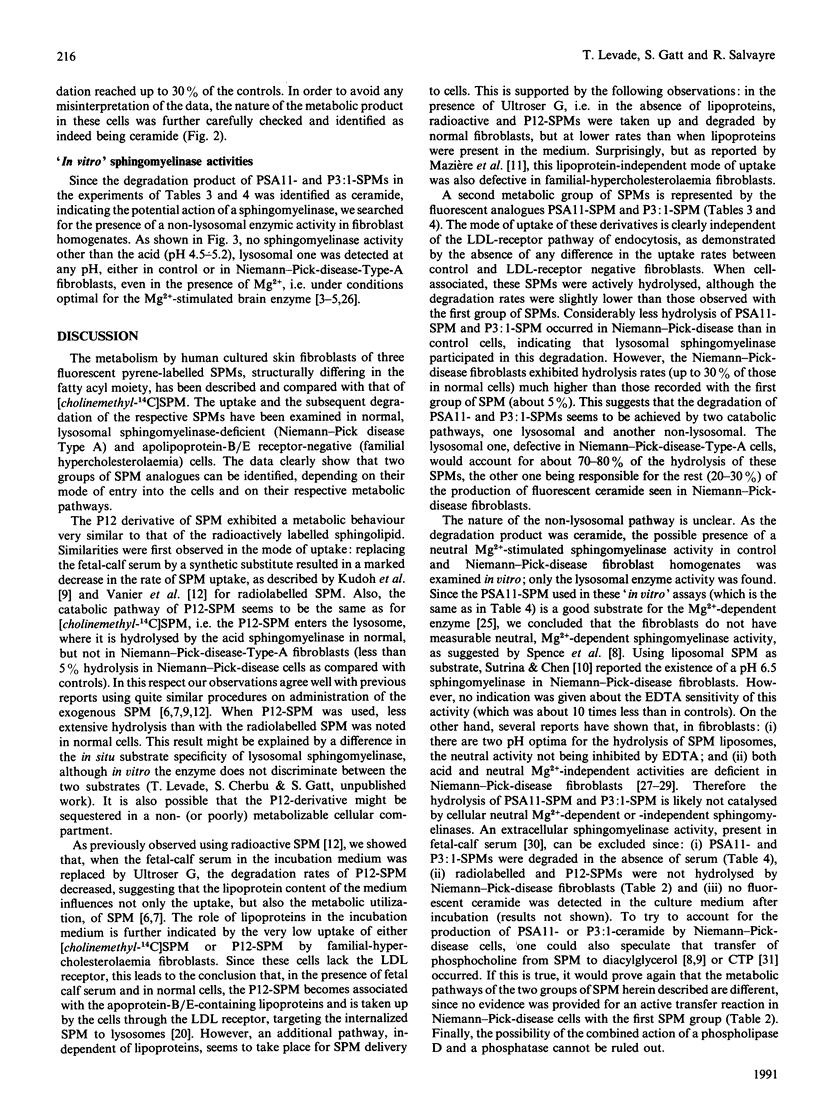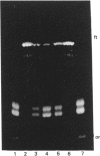Abstract
Three fluorescent analogues of sphingomyelin (SPM), each containing pyrene in the fatty acyl residue, were synthesized and employed for the study of their mode of uptake by, and degradation within, intact cultured human skin fibroblasts. These were prepared by condensing sphingosylphosphocholine and the following fatty acids: pyrenedodecanoic acid (P12), pyrenesulphonylaminoundecanoic acid (PSA11) and pyrenepropenoic acid (P3:1). The cell association and catabolism of these SPM analogues by normal, Niemann-Pick-disease-Type-A and low-density-lipoprotein (LDL)-receptor-negative familial hypercholesterolaemia fibroblasts were investigated and compared with the metabolism of [cholinemethyl-14C]sphingomyelin. The catabolism of the fluorescent derivatives was monitored by measuring the appearance of the corresponding fluorescent ceramides. Two modes of uptake and degradation patterns were observed. Thus P12-SPM and radiolabelled SPM were taken up by LDL-receptor-mediated endocytosis when incubated with serum-containing medium, this conclusion being supported by the very low uptake by familial-hypercholesterolaemia fibroblasts, which lack the apolipoprotein-B/E receptor. After uptake, these compounds were metabolically degraded solely by the lysosomal sphingomyelinase, as evidenced by the fact that more than 98% of the SPM remained undegraded in Niemann-Pick-disease cells. By contrast, PSA11- and P3:1-SPMs were taken up by a receptor-independent endocytic pathway, as indicated by the similar rates of uptake in control and familial-hypercholesterolaemia cells in the absence or presence of fetal-calf serum in the culture medium. The degradation of PSA11-SPM and P3:1-SPM was brought about, in the main, by the lysosomal sphingomyelinase, but also by a yet uncharacterized process. The latter catabolic pathway, active in Niemann-Pick-disease-Type-A fibroblasts, seems to differ from the neutral Mg2(+)-dependent sphingomyelinase whose activity was undetectable in homogenates of skin fibroblasts. The present study emphasizes the influence of the structure of the fatty acyl moiety of SPM on its association with lipoproteins and/or cell membranes and on its intracellular routing and metabolic degradation.
Full text
PDF






Images in this article
Selected References
These references are in PubMed. This may not be the complete list of references from this article.
- Ahmad T. Y., Sparrow J. T., Morrisett J. D. Fluorine-, pyrene-, and nitroxide-labeled sphingomyelin: semi-synthesis and thermotropic properties. J Lipid Res. 1985 Sep;26(9):1160–1165. [PubMed] [Google Scholar]
- Beaudet A. L., Manschreck A. A. Metabolism of sphingomyelin by intact cultured fibroblasts: differentiation of Niemann-Pick disease type A and B. Biochem Biophys Res Commun. 1982 Mar 15;105(1):14–19. doi: 10.1016/s0006-291x(82)80004-1. [DOI] [PubMed] [Google Scholar]
- Cohen R., Barenholz Y., Gatt S., Dagan A. Preparation and characterization of well defined D-erythro sphingomyelins. Chem Phys Lipids. 1984 Oct;35(4):371–384. doi: 10.1016/0009-3084(84)90079-3. [DOI] [PubMed] [Google Scholar]
- FOLCH J., LEES M., SLOANE STANLEY G. H. A simple method for the isolation and purification of total lipides from animal tissues. J Biol Chem. 1957 May;226(1):497–509. [PubMed] [Google Scholar]
- Forte T. M., Bell-Quint J. J., Cheng F. Lipoproteins of fetal and newborn calves and adult steer: a study of developmental changes. Lipids. 1981 Apr;16(4):240–245. doi: 10.1007/BF02535023. [DOI] [PubMed] [Google Scholar]
- GAVER R. C., SWEELEY C. C. METHODS FOR METHANOLYSIS OF SPHINGOLIPIDS AND DIRECT DETERMINATION OF LONG-CHAIN BASES BY GAS CHROMATOGRAPHY. J Am Oil Chem Soc. 1965 Apr;42:294–298. doi: 10.1007/BF02540132. [DOI] [PubMed] [Google Scholar]
- Gatt S., Barenholz Y., Goldberg R., Dinur T., Besley G., Leibovitz-Ben Gershon Z., Rosenthal J., Desnick R. J., Devine E. A., Shafit-Zagardo B. Assay of enzymes of lipid metabolism with colored and fluorescent derivatives of natural lipids. Methods Enzymol. 1981;72:351–375. doi: 10.1016/s0076-6879(81)72026-3. [DOI] [PubMed] [Google Scholar]
- Goldstein J. L., Brown M. S. Binding and degradation of low density lipoproteins by cultured human fibroblasts. Comparison of cells from a normal subject and from a patient with homozygous familial hypercholesterolemia. J Biol Chem. 1974 Aug 25;249(16):5153–5162. [PubMed] [Google Scholar]
- Hartree E. F. Determination of protein: a modification of the Lowry method that gives a linear photometric response. Anal Biochem. 1972 Aug;48(2):422–427. doi: 10.1016/0003-2697(72)90094-2. [DOI] [PubMed] [Google Scholar]
- Klar R., Levade T., Gatt S. Synthesis of pyrenesulfonylamido-sphingomyelin and its use as substrate for determining sphingomyelinase activity and diagnosing Niemann-Pick disease. Clin Chim Acta. 1988 Sep 15;176(3):259–267. doi: 10.1016/0009-8981(88)90185-4. [DOI] [PubMed] [Google Scholar]
- Koval M., Pagano R. E. Lipid recycling between the plasma membrane and intracellular compartments: transport and metabolism of fluorescent sphingomyelin analogues in cultured fibroblasts. J Cell Biol. 1989 Jun;108(6):2169–2181. doi: 10.1083/jcb.108.6.2169. [DOI] [PMC free article] [PubMed] [Google Scholar]
- Kudoh T., Velkoff M. A., Wenger D. A. Uptake and metabolism of radioactively labeled sphingomyelin in cultured skin fibroblasts from controls and patients with Niemann-Pick disease and other lysosomal storage diseases. Biochim Biophys Acta. 1983 Nov 1;754(1):82–92. doi: 10.1016/0005-2760(83)90084-x. [DOI] [PubMed] [Google Scholar]
- Levade T., Gatt S. Uptake and intracellular degradation of fluorescent sphingomyelin by fibroblasts from normal individuals and a patient with Niemann-Pick disease. Biochim Biophys Acta. 1987 Apr 24;918(3):250–259. doi: 10.1016/0005-2760(87)90228-1. [DOI] [PubMed] [Google Scholar]
- Levade T., Salvayre R., Douste-Blazy L. Comparative hydrolysis of sphingomyelin and 2-N-(hexadecanoyl)-amino-4-nitrophenyl-phosphorylcholine by normal human brain homogenate at acid and neutral pH. J Neurochem. 1983 Jun;40(6):1762–1764. doi: 10.1111/j.1471-4159.1983.tb08153.x. [DOI] [PubMed] [Google Scholar]
- Levade T., Salvayre R., Douste-Blazy L. Sphingomyelinases and Niemann-Pick disease. J Clin Chem Clin Biochem. 1986 Apr;24(4):205–220. [PubMed] [Google Scholar]
- Mazière J. C., Mazière C., Mora L., Polonovski J. Impairment of exogenous sphingomyelin degradation in cultured fibroblasts from familial hypercholesterolemia. FEBS Lett. 1984 Jul 23;173(1):159–163. doi: 10.1016/0014-5793(84)81038-8. [DOI] [PubMed] [Google Scholar]
- Morand O., Fibach E., Dagan A., Gatt S. Transport of fluorescent derivatives of fatty acids into cultured human leukemic myeloid cells and their subsequent metabolic utilization. Biochim Biophys Acta. 1982 Jun 11;711(3):539–550. doi: 10.1016/0005-2760(82)90070-4. [DOI] [PubMed] [Google Scholar]
- Pagano R. E., Martin O. C. A series of fluorescent N-acylsphingosines: synthesis, physical properties, and studies in cultured cells. Biochemistry. 1988 Jun 14;27(12):4439–4445. doi: 10.1021/bi00412a034. [DOI] [PubMed] [Google Scholar]
- Poulos A., Ranieri E., Shankaran P., Callahan J. W. Studies on the activation of the enzymatic hydrolysis of sphingomyelin liposomes. Biochim Biophys Acta. 1984 Apr 18;793(2):141–148. doi: 10.1016/0005-2760(84)90315-1. [DOI] [PubMed] [Google Scholar]
- Radom J., Salvayre R., Levade T., Douste-Blazy L. Influence of chain length of pyrene fatty acids on their uptake and metabolism by Epstein-Barr-virus-transformed lymphoid cell lines from a patient with multisystemic lipid storage myopathy and from control subjects. Biochem J. 1990 Jul 1;269(1):107–113. doi: 10.1042/bj2690107. [DOI] [PMC free article] [PubMed] [Google Scholar]
- Sato M., Yoshida Y., Sakuragawa N., Arima M. Effects of dimethylsulfoxide on sphingomyelinase activities in normal and Niemann-Pick type A, B and C fibroblasts. Biochim Biophys Acta. 1988 Sep 2;962(1):59–65. [PubMed] [Google Scholar]
- Spence M. W., Burgess J. K., Sperker E. R. Neutral and acid sphingomyelinases: somatotopographical distribution in human brain and distribution in rat organs. A possible relationship with the dopamine system. Brain Res. 1979 Jun 8;168(3):543–551. doi: 10.1016/0006-8993(79)90308-1. [DOI] [PubMed] [Google Scholar]
- Spence M. W., Byers D. M., Palmer F. B., Cook H. W. A new Zn2+-stimulated sphingomyelinase in fetal bovine serum. J Biol Chem. 1989 Apr 5;264(10):5358–5363. [PubMed] [Google Scholar]
- Spence M. W., Clarke J. T., Cook H. W. Pathways of sphingomyelin metabolism in cultured fibroblasts from normal and sphingomyelin lipidosis subjects. J Biol Chem. 1983 Jul 25;258(14):8595–8600. [PubMed] [Google Scholar]
- Spence M. W., Cook H. W., Byers D. M., Palmer F. B. The role of sphingomyelin in phosphatidylcholine metabolism in cultured human fibroblasts from control and sphingomyelin lipidosis patients and in Chinese hamster ovary cells. Biochem J. 1990 Jun 15;268(3):719–724. doi: 10.1042/bj2680719. [DOI] [PMC free article] [PubMed] [Google Scholar]
- Stein O., Oette K., Hollander G., Dabach Y., Ben-Naim M., Stein Y. Divergent fate of unsaturated and saturated ceramides and sphingomyelins in rat liver and cells in culture. Biochim Biophys Acta. 1989 Jun 8;1003(2):175–182. doi: 10.1016/0005-2760(89)90252-x. [DOI] [PubMed] [Google Scholar]
- Stoffel W., Melzner I. Studies in vitro on the biosynthesis of ceramide and sphingomyelin. A reevaluation of proposed pathways. Hoppe Seylers Z Physiol Chem. 1980 May;361(5):755–771. doi: 10.1515/bchm2.1980.361.1.755. [DOI] [PubMed] [Google Scholar]
- Sutrina S. L., Chen W. W. Lysosomal involvement in cellular turnover of plasma membrane sphingomyelin. Biochim Biophys Acta. 1984 Apr 18;793(2):169–179. doi: 10.1016/0005-2760(84)90318-7. [DOI] [PubMed] [Google Scholar]
- Vanier M. T., Rousson R., Garcia I., Bailloud G., Juge M. C., Revol A., Louisot P. Biochemical studies in Niemann-Pick disease. III. In vitro and in vivo assays of sphingomyelin degradation in cultured skin fibroblasts and amniotic fluid cells for the diagnosis of the various forms of the disease. Clin Genet. 1985 Jan;27(1):20–32. doi: 10.1111/j.1399-0004.1985.tb00180.x. [DOI] [PubMed] [Google Scholar]
- Yoshida Y., Arimoto K., Sato M., Sakuragawa N., Arima M., Satoyoshi E. Reduction of acid sphingomyelinase activity in human fibroblasts induced by AY-9944 and other cationic amphiphilic drugs. J Biochem. 1985 Dec;98(6):1669–1679. doi: 10.1093/oxfordjournals.jbchem.a135438. [DOI] [PubMed] [Google Scholar]



